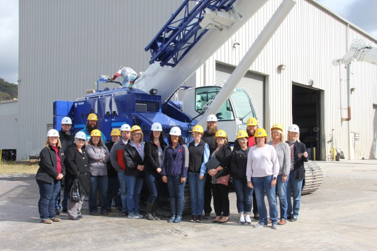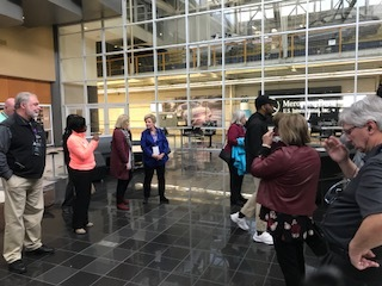Betty Hale, Senior Fellow, IEL and Sarah McCann, IEL Consultant
The need for increased collaboration is a primary theme across nearly all recommendations for resolving the workforce challenges facing rural places and organizations. Increasingly, there is also a call for increased collaboration between the education and workforce systems to address today’s workforce and workplace needs all across the nation.
Working together sounds like a simple solution, right? Not so fast.
Neither organizations nor systems collaborate; the people in them collaborate. But, outdated organizational structures and operational processes developed in and for a different time make it difficult, if not impossible, for individuals to work across organizational boundaries. In the specific case of collaboration between the education and workforce systems, most educators have a lack of knowledge about workforce organizations and most workforce staff have a lack of knowledge about today’s schools. The lack of knowledge about each other’s work is a huge barrier to working together.
Two organizations in Appalachia – the United Way of Southwest Virginia (UWSWVA) and West Alabama Works (WAW) – have mounted programs that address the need to provide educators with increased knowledge about the workforce – systems as well as businesses – in their immediate area.
The service area of The United Way of Southwest Virginia covers 15 counties and four cities. Its work is focused on preparing tomorrow’s workforce for the jobs of tomorrow, supplying businesses with skilled workers, and building a robust, competitive economy in the region.
Through one component of its Ignite initiative, UWSWVA conducts the “Educators in Industry” Tours program. Started in 2016, this learning opportunity is making it possible for staff in middle schools – teachers, counselors, and assistant principals – to become more aware of and knowledgeable about the region’s businesses, employment opportunities and job requirements in their region.
The program is also preparing educators to meet the Virginia education policy mandating that each seventh-grade student must begin to develop a personal Academic and Career Plan (ACP) and to complete it by the fall of their eighth-grade year. The “Educators in Industry” Tours program is a response to both employer and school system needs.
Nineteen school districts are partners in the Ignite initiative and have a school-based coordinator. Staff members from these districts are invited to apply to participate in the Educators in Industry” Tours program. The application process requires applicants to agree to incorporate what they learn into their classrooms and, equally important, to present what they learn to peers at their school. Five “Educators in Industry” Tours are offered per year and each tour visits three companies. Generally, each cohort accommodates between 20-25 participants.
After each tour, participants debrief the experience to identify what they observed; discuss the priority skills required, including the so-called soft skills; and highlight major lessons learned. The UWSWVA covers the cost of substitute teachers, provides lunch, and pays travel expenses related to carpooling to the business site.

Pictured left: Educators at Tadona Mantis – VA
Both educators and business leaders are in agreement–the “Educator in Industry” Tours program is extremely valuable.
“Thank you for recognizing that agriculture is such a vital part of our region.” It’s so important for the educators to teach science and business-related material. . .We need to expose students to these things.”
-Highlands Dairy Farm
“Attendance is such a huge issue in this region. Getting employees to show up and actually work has been a struggle. We are extremely appreciative of any educator that teaches soft skills like time management, teamwork, and communication skills.”
-Misty Mountain KVAT
“Computer Science is the economy of the future. We really appreciate any interest that educators can give to the industry. IT is coming and it is coming fast.”
-Wize Solutions
“I’ve learned that employers in the region can’t stress enough how important a good work ethic is. It is so important to relay the message of soft skills to the students.”
-Marion Middle School
Since educators often promote college as the best or only route to career success, there are big knowledge gaps about preparing for and the experience of working in business and industry. To address these gaps and to bolster the K-12 pipeline in the nine counties service area, West Alabama Works (WAW) launched the “Educator-Workforce Academy.” The program introduces educators to employment opportunities and successful pathways to well-paying careers that do not require a 4-year college degree. They learn about 2-year degrees and/or apprenticeships and/or on-the-job training programs.
WAW’s goal is for leaders at every level of the school to participate, starting at the top, to build support and strategic bridges between the education and workforce systems. Participants in the early cohorts were superintendents, principals, and assistant principals, but the 75 leaders in the 2019 program are counselors, lead teachers, career and technical education directors, and office administrators. To date, 145 leaders have graduated from the Academy and, in some school systems, most of the school leaders have participated.
Participants in the Academy are given a firsthand introduction to career exploration activities as well as opportunities to visit business sites in the area. WAW kicks off the Academy at its annual World of Work exhibit, an event showcasing jobs and employers to students in 8th to 12th grade. There are three more sessions throughout the year where participants hear from business leaders and visit businesses such as Mercedes Benz, the largest employer in the region.
Pictured below: WAW Educators at Mercedes-Benz U.S. International
 The educators meet with employees to learn about their work experience, which can include discussions with individuals who came to their jobs straight out of high school and now earn salaries of $150,000 in trades such as welding. Participants also learn about the available jobs and what it takes to do them, and they take this information back to their schools and their students. Guest speakers present on topics such as apprenticeships and the community college system, but the discussion topics vary as awareness about workforce development trends and needs shift.
The educators meet with employees to learn about their work experience, which can include discussions with individuals who came to their jobs straight out of high school and now earn salaries of $150,000 in trades such as welding. Participants also learn about the available jobs and what it takes to do them, and they take this information back to their schools and their students. Guest speakers present on topics such as apprenticeships and the community college system, but the discussion topics vary as awareness about workforce development trends and needs shift.
At the end of the year, participants debrief by school or system. They consider how they can use their education lens to support their students in pursuing the workforce opportunities they’ve seen. To ‘graduate,’ Academy participants must present a written action plan. Participants receive professional learning units (PLUs) from the state – another example of collaboration between the two sectors. WAW partners with school staff to get principals more engaged and one of the schools takes on the role of coordinating the PLUs and action plans.
Academy graduates learned that soft skills are the most important thing that schools can do to ensure that students are prepared for a career and some schools are implementing targeted action plans incorporating such skills. At the elementary school level, many young children don’t have social skills that employers expect such as looking someone in the eyes and greeting them. Some schools have incorporated a daily handshake and greeting into their school days. Now, students greet their teacher every day or take turns being the handshake buddy. With older students, absenteeism, as well as tardiness, are issues that are taken more seriously.
A barrier for some students is parents who are also new to thinking about alternatives to a 4-year college degree career pathway or parents who still consider blue-collar jobs as “dirty jobs” or “jobs for other people’s children.” WAW gets parents involved in the Worlds of Work event and is working on becoming more creative in reaching out to families to share success. To document the Academy’s impact, WAW started follow up sessions with graduates to see how they are implementing ideas and action plans. WAW plans to use its funding to dive deeper into the impact.
WAW originally planned to scale back the Academy once all of the school system leaders have participated, however, the program has been so successful that it is currently scheduled to run indefinitely until WAW sees a slowdown in interest.
A recent article in Forbes, “How Collaboration Can Address Both Education And Economic Inequality,” reinforces the importance of promoting closer connections between education and workforce. The author says, “. . . the world of K-12 education and the world of work look very different—and don’t cross paths much. While there has been some improvement over the years, coordination is rare, data sharing is challenging, oversight and accountability [are] fractured, and funding is separate.” The “Educators in Industry” Tours in Appalachian Virginia and the Educator-Workforce Academy in Appalachian Alabama will not by themselves change the overall status of collaboration between the education and workforce systems. But both programs and the learning opportunities provided to educators are a giant step in the right direction.
To learn more about the Virginia and Alabama programs, please feel free to contact Melinda Leland – mleland@unitedwayswva.org (VA) and Brittani Colburn – Brittani@tuscaloosachamber.com (AL).
